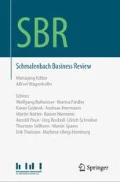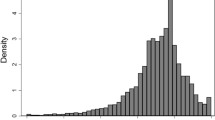Abstract
We evaluate the effects of employer-provided formal training on employee suggestions for productivity improvements and on promotions among male blue-collar workers. Using more than 20 years of personnel data of four entry cohorts in a German company, we address issues such as unobserved heterogeneity and the length of potential training effects. Our main finding is that workers are more likely to make suggestions and to be promoted after they have received formal training. However, the effect on suggestions is only short term. Promotion probabilities are greatest directly after training, but also seem to be affected in the long term.
Similar content being viewed by others
References
Acemoglu, Daron and Jörn-Steffen Pischke (1998), Why do firms train? Theory and evidence, Quarterly Journal of Economics 113, 79—119.
Aguinis, Herman and Kurt Kraiger (2009), Benefits of Training and Development for Individuals and Teams, Organizations, and Society, Annual Review of Psychology 60, 451—474.
Akerlof, George A. (1982), Labor contracts as partial gift exchange, Quarterly Journal of Economics 97 (4), 543—569.
Angrist, Joshua D. (2001), Estimation of limited dependent variable models with dummy endogenous regressors: Simple strategies for empirical practice, Journal of Business and Economic Statistics 19 (1), 2—16.
Arnold, John and Kate M. Davey (1999), Graduates’ Work Experiences as Predictors of Organisational Commitment, Intention to Leave and Turnover, Which Experiences Really Matter?, Applied Psychology 48 (2), 211—238.
Asplund, Rita (2005), The Provision and Effects of Company Training: A Brief Review of the Literature, Nordic Journal of Political Economy 31, 47—73.
Baker, George, Gibbs, M., and Bengt Holmstrom (1994a), The Internal Economics of the Firm: Evidence from Personnel Data, Quarterly Journal of Economics 109 (4), 881—920.
Baker, George, Michael Gibbs, and Bengt Holmstrom (1994b), The Wage Policy of a Firm, Quarterly Journal of Economics 109 (4), 921—956.
Barber, Jamie (2004), Skill upgrading within informal training: Lessons from the Indian auto mechanic, International Journal of Training and Development 8(2), 129—139.
Barrett, Alan and Philip J. O’Connell (2001), Does Training Generally Work? The Return to In-Company Training, Industrial and Labor Relations Review 54 (3), 647—662.
Barron, John M., Mark C. Berger, and Dan A. Black (1999), Do Workers Pay for On-The-Job Training, Journal of Human Resources 34 (2), 235—252.
Bartel, Ann P. (1995), Training, wage growth, and job performance: Evidence from a company database, Journal of Labor Economics 13, 401—425.
Bartel, Ann P. (2000), Measuring the Employer’s Return on Investments in Training: Evidence from Literature, Industrial Relations 39 (3), 502—524.
Bartel, Ann P., Casey Ichniowski, and Kathryn L. Shaw (2004), Using “insider econometrics” to study productivity, American Economic Review 94 (2), 217—223.
Becker, Gary S. (1962), Investments in human capital: a theoretical analysis, Journal of Political Economy 7 (5), 9—49.
Becker, Gary S. (1993), Human Capital: A Theoretical and Empirical Analysis with a Special Reference to Education, University Chicago Press, Chicago.
Bishop, John H. (1997), What we know about employer-provided training: a review of the literature, Research in Labor Economics 16, 19—87.
Black, Sandra E. and Lisa M. Lynch (1996), Human—Capital Investments and Productivity, American Economic Review, Paper and Proceedings 86 (2), 263—267.
Black, Sandra E. and Lisa M. Lynch (2001), How to compete: The impact of workplace Practices and Information technology on Productivity, Review of Economics and Statistics 83 (3), 434—445.
Booth, Alison L. (1993), Private Sector Training and Graduate Earnings, Review of Economics and Statistics 75 (1), 164—170.
Breuer, Kathrin, and Patrick Kampkötter (2010), The effects of intra-firm training on earnings and job performance — evidence from a large German company, Paper presented at EALE/SOLE Meeting 2010.
Cabrera, Angel, William C. Collins, and Jesus F. Salgado (2006), Determinants of individual engagement in knowledge sharing, Internal Journal of Human Resource Management 17 (2), 245—264.
Conti, G. (2005), Training, productivity and wages in Italy, Labour Economics 12 (4), 557—576.
Dearden, Lorraine, Howard Reed, and John van Reenen (2006), The Impact of Training on Productivity and Wages: Evidence from British Panel Data, Oxford Bulletin of Economics and Statistics 68 (4), 397—421.
Fahr, Rene, and Sabine Simons (2008), Returns to company training: Evidence from a new approach using quasi experimental data. Mimeo.
Ford, Cameron M. (1996), A Theory of Individual Creative Action in Multiple Social Domains, Academy of Management Review 21 (4), 1112–1142.
Frazis, Harley and Mark A. Loewenstein (2005), Reexamining the returns to training: Functional form, magnitude, and interpretation, Journal of Human Resources 40 (2), 453–476.
Gerfin, Michael (2004), Work-related training and wages: An Empirical analysis for male workers in Switzerland. IZA Discussion Paper No. 1078.
Heckman, James J. (1981), The incidental parameters problem and the problem of initial conditions in estimating a discrete time-discrete data stochastic process, in Charles F. Manski and Daniel McFadden (eds.), Structural analysis of discrete data with econometric applications, MIT Press, Cambridge, 179–195.
Krueger, Alan B. and Cecilia E. Rouse (1998), The Effect of Workplace Education on Earnings, Turnover, and Job Performance, Journal of Labor Economics 16 (1), 61–94.
Lazear, Edward P. and Paul Oyer (2013), Personnel Economics, Forthcoming in R. Gibbons and J. Roberts (eds.), Handbook of Organizational Economics, Princeton University Press, Princeton, 479–519.
Leuven, Edwin (2004), A Review of the Wage Returns to Private Sector Training, Paper presented at the EC_OECD Seminar in Human Capital and Labour Market Performance: Evidence and Policy Challenges. Brussels.
Leuven, Edwin and Hessel Oosterbeek (1999), The demand and supply of work-related training: Evidence from four countries, Research in Labor Economics 18, 303–330.
Leuven, Edwin and Hessel Oosterbeek (2004), Evaluating the Effect of Tax Deductions on Training, Journal of Labor Economics 22 (2), 461–488.
Leuven, Edwin and Hessel Oosterbeek (2008), An Alternative Approach to Estimate the Wage Returns to Private Sector Training, Journal of Applied Econometrics 23, 423–434.
Leuven, Edwin, Hessel Oosterbeek, Randolph Sloof, and Chris van Klaveren (2008), Worker Reciprocity and Employer Investment in Training, Economica 72, 137–149.
Lynch, Lisa M. (1992), Private-Sector Training and the Earnings of Young Workers, American Economic Review 82 (1), 299–312.
Metcalf, David (2004), The impact of the national minimum wage on the pay distribution, employment and training, Economic Journal 114 (494), C84–C86.
Mincer, Jacob A. (1974), Schooling, Experience, and Earnings, Columbia University Press, New York.
Muehler, Grit, Michael Beckmann, and Bernd Schauenberg (2007), The returns to continuous training in Germany: New Evidence from propensity score matching estimators, Review of Managerial Science 1, 209–235.
Neumark, David and William Wascher (2001), Minimum Wages and Training Revisited, Journal of Labor Economics 19 (3), 563–595.
Pischke, Jörn-Steffen (2001), Continuous Training in Germany, Journal of Population Economics 14 (3), 523–548.
Schmidt, Steven W. (2007), The relationship between satisfaction with workplace training and overall job satisfaction, Human Resource Development Quarterly 18 (4), 481–498.
Schøne, Pål (2004), Why is the return to training so high?, Labour 18, 363–378.
Shaw, K. (2009), Insider econometrics: a roadmap with stops along the way, Labour Economics 16 (6), 607–617.
Veum, Jonathan R. (1995), Sources of Training and Their Impact on Wages, Industrial and Labor Relations Review 48 (4), 812–826.
Wooldridge Jeffrey M. (2002), Econometric analysis of cross section and panel data, MIT Press, Cambridge.
Zwick, Thomas (2005), Continuing Vocational Training Forms and Establishment Productivity in Germany, German Economic Review 6 (2), 155–184.
Author information
Authors and Affiliations
Corresponding author
Additional information
Acknowledgements: This work was supported financially by the VolkswagenStiftung. We thank two referees of this journal and seminar participants at Leuphana University Lüneburg, University Paderborn, the 14th Colloquium in Personnel Economics 2011 in Zurich, and EALE conference 2011 in Cyprus for their comments.
Rights and permissions
About this article
Cite this article
Christian, P., Janssen, S., Yang, P. et al. Effects of Training on Employee Suggestions and Promotions: Evidence from Personnel Records. Schmalenbach Bus Rev 65, 270–287 (2013). https://doi.org/10.1007/BF03396858
Published:
Issue Date:
DOI: https://doi.org/10.1007/BF03396858




